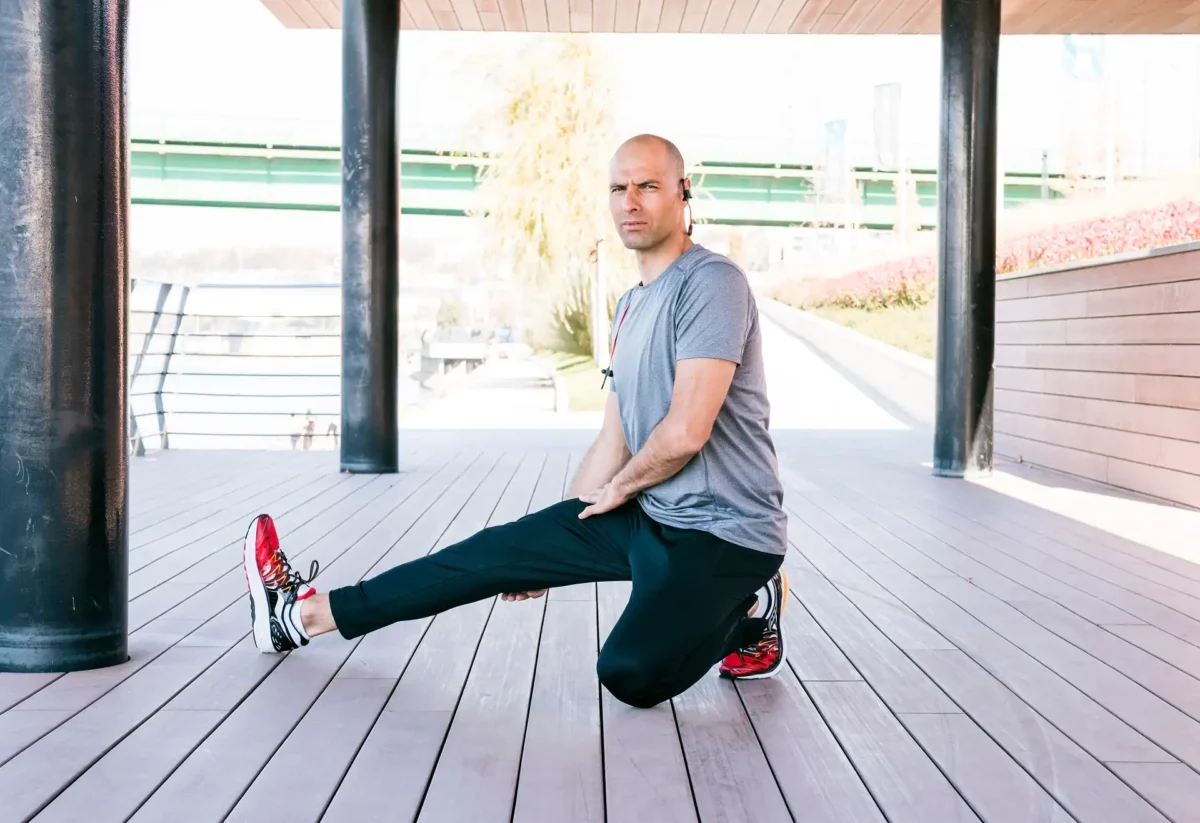Like a well-oiled machine, your body craves movement and flexibility to perform at its peak. You’ll discover how resistance band stretches can transform your mobility and strength, just as Arnold mastered every aspect of his training to become Mr. Olympia.
Suppose you’re ready to activate your body’s full potential through a proven combination of stretches that target every major muscle group. In that case, you’re about to learn the exact techniques that’ll take your fitness journey to the next level.
The Importance Of Flexibility In Fitness
Flexibility helps athletes move more efficiently and reduces the risk of injuries. Stretching muscles keeps them strong and healthy. Athletes can perform at their best with good flexibility. Band stretches are a great way to improve flexibility.
They target specific muscle groups. This helps athletes focus on areas that need attention. Flexible muscles recover faster after workouts. This means athletes can train more often and improve their skills.
Good flexibility makes daily tasks easier. Bending, reaching, and lifting become simple. Stretching reduces the risk of strains and sprains. Flexible muscles help you move with ease.
Band stretches can be done anywhere and at any time. They are easy to include in your routine. Regular stretching keeps your body feeling great.
Introduction To Band Stretches
Band stretches enhance flexibility, improve muscle strength, and help prevent injuries. These exercises are versatile and suitable for all fitness levels.
1. What Are Band Stretches?
Band stretches use elastic bands to improve flexibility and strength. These bands provide resistance. They are great for both warm-ups and cool-downs. Many athletes use them to prevent injuries. They are also helpful in physical therapy.
2. Types Of Stretch Bands
There are various types of stretch bands. Here are some common ones:
| Type | Description |
| Loop Bands | These are circular. They are ideal for lower-body exercises. |
| Therapy Bands | These are flat. They are often used in rehab exercises. |
| Tubing Bands | These have handles. They are great for upper-body workouts. |
Overview of Resistance Band Stretches
Before diving into specific exercises, you’ll want to understand the fundamental approach to resistance band stretching and what makes it uniquely effective. Unlike traditional static stretching, resistance bands provide gentle, controlled tension that helps you gradually increase your range of motion.
You’ll be performing each stretch for 15-30 seconds, focusing on proper form and breathing. The beauty of resistance band work is that you can adjust the intensity by simply repositioning your grip on the band.
As Arnold often said, “The last three or four repetitions are what makes the muscle grow” – the same principle applies here with progressive stretching.
Remember to:
- Stretch both sides equally
- Complete two cycles when time permits
- Listen to your body’s limits
- Keep movements slow and controlled
- Maintain steady breathing throughout
Warm-Up
Just as Arnold famously said, “The pump is like a rush,” getting your blood flowing before stretching creates that same energized feeling throughout your body.
Before you grab that resistance band, you’ll need to wake up those muscles with proper cardiovascular activity.
Here’s your pre-stretch warm-up protocol:
- Walk briskly, ride a bike, or jog in place for 10 minutes
- Maintain a pace where you’re slightly breathless but can still hold a conversation
- Focus on getting your heart rate up and blood circulating to all muscle groups
Remember: Stretching isn’t a warm-up on its own – it’s what comes after your muscles are already warm and pliable.
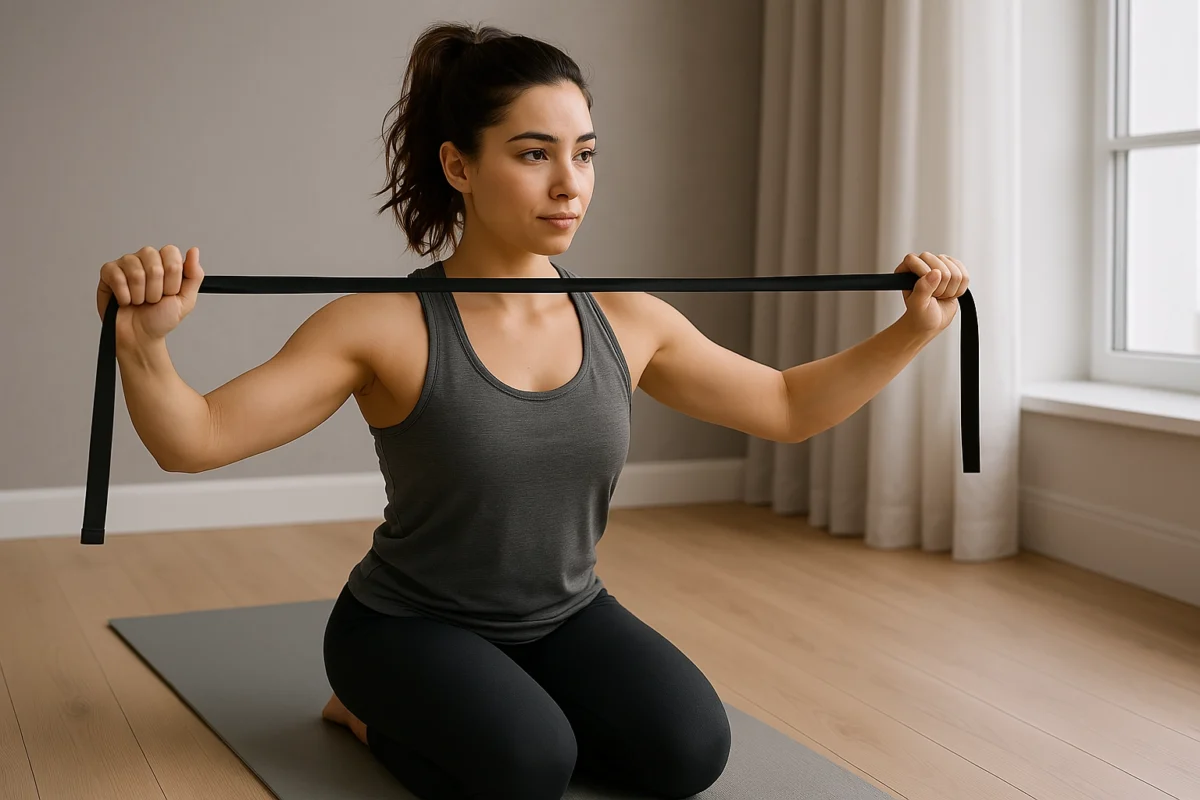
You can also perform your resistance band stretches after any cardio workout, when your body is already primed for action.
The Workout
You’ll learn five essential resistance band stretches that target major muscle groups from head to toe.
Working through hamstrings, inner thighs, hips, upper back, and chest, you’ll improve flexibility in areas that often get tight from daily activities and workouts.
These stretches, which Arnold himself incorporated into his legendary training routines, will help you maintain better posture and reduce muscle tension when performed regularly.
#Hamstring Stretch
The resistance band hamstring stretch targets one of the most commonly tight muscle groups while allowing precise control over the intensity.
Here’s how to perform it properly:
- Lie on your back and loop the resistance band around your right foot
- Grab the band close to your foot to create tension
- Keep your left leg bent with your foot flat on the floor
- Straighten your right leg while gently pulling it toward you
- Maintain square hips on the mat throughout the movement
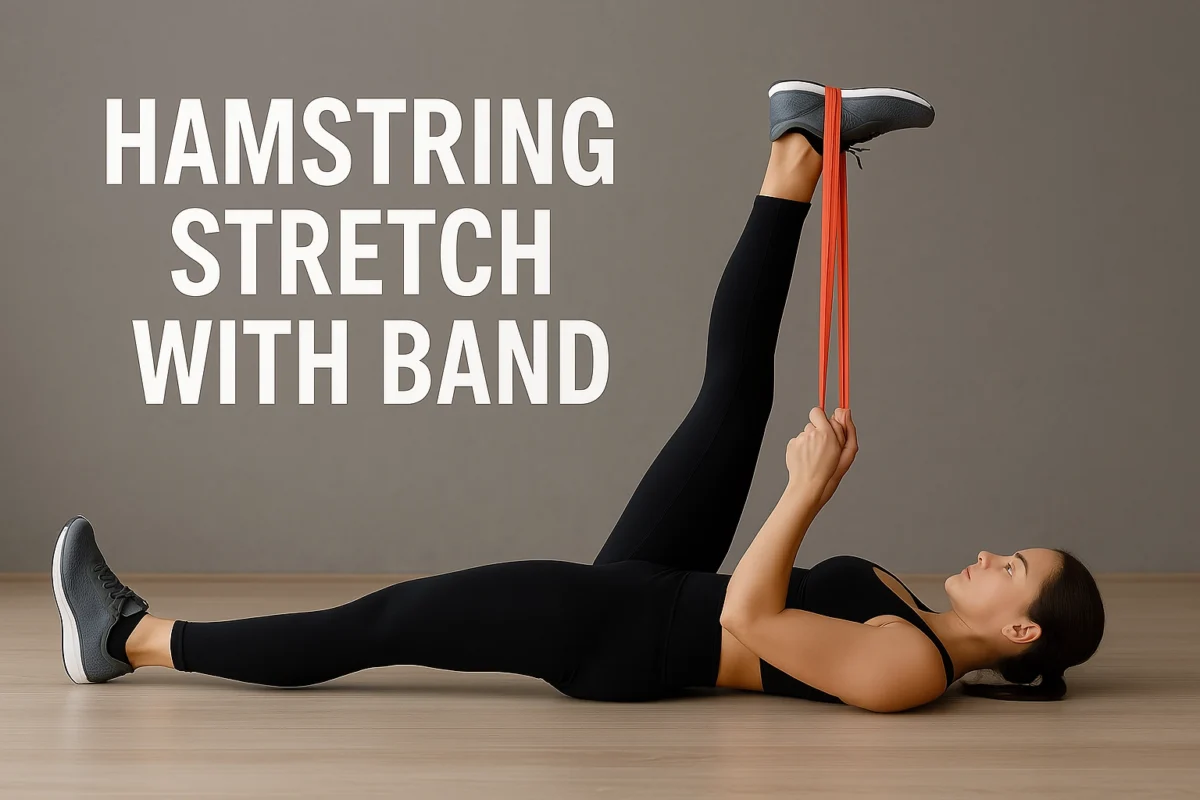
Hold the stretch for 15-30 seconds on each side, but don’t push to the point of pain.
As Arnold would say, “Listen to your body.”
Research shows that overly aggressive stretching can decrease muscle performance; therefore, focus on a controlled, comfortable stretch that effectively targets the back of your leg.
#Inner Thigh Stretch
Ready to target those hard-to-reach adductor muscles? This resistance band variation of the inner thigh stretch helps you achieve maximum flexibility while maintaining control of the movement.
Lie flat on your back and wrap the resistance band around your right foot. Grip the band with your right hand, creating tension that’ll help guide your stretch.
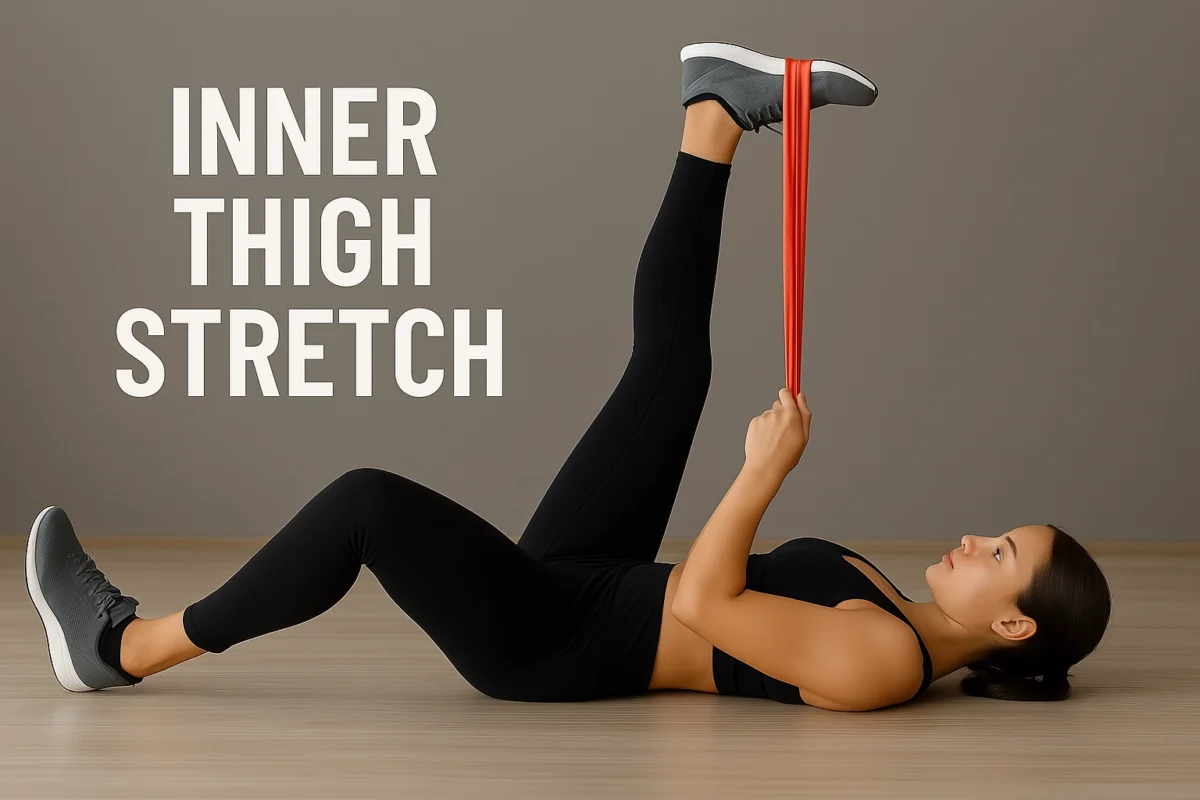
Slowly lower your right leg out to the side, moving toward the floor until you feel the stretch activate in your inner thigh muscles. For added control and safety, use your free hand to support the working leg – simply hold both ends of the band in one hand.
As Arnold would say, “The mind controls the body,” so maintain focus throughout the 15-30 second hold. Switch sides and repeat to promote balanced flexibility development.
#Lying Hip Stretch
While tight hip flexors can wreak havoc on your lower back mobility, this lying hip stretch with resistance bands offers targeted relief that would make Arnold proud.
Here’s how to execute with precision:
- Lie flat on your back and secure the resistance band around your right foot.
- Hold the band with your left hand while extending your left leg straight on the floor.
- Lower your right leg across your body toward the left side, maintaining control.
- Keep your shoulders firmly planted and parallel to the ceiling.
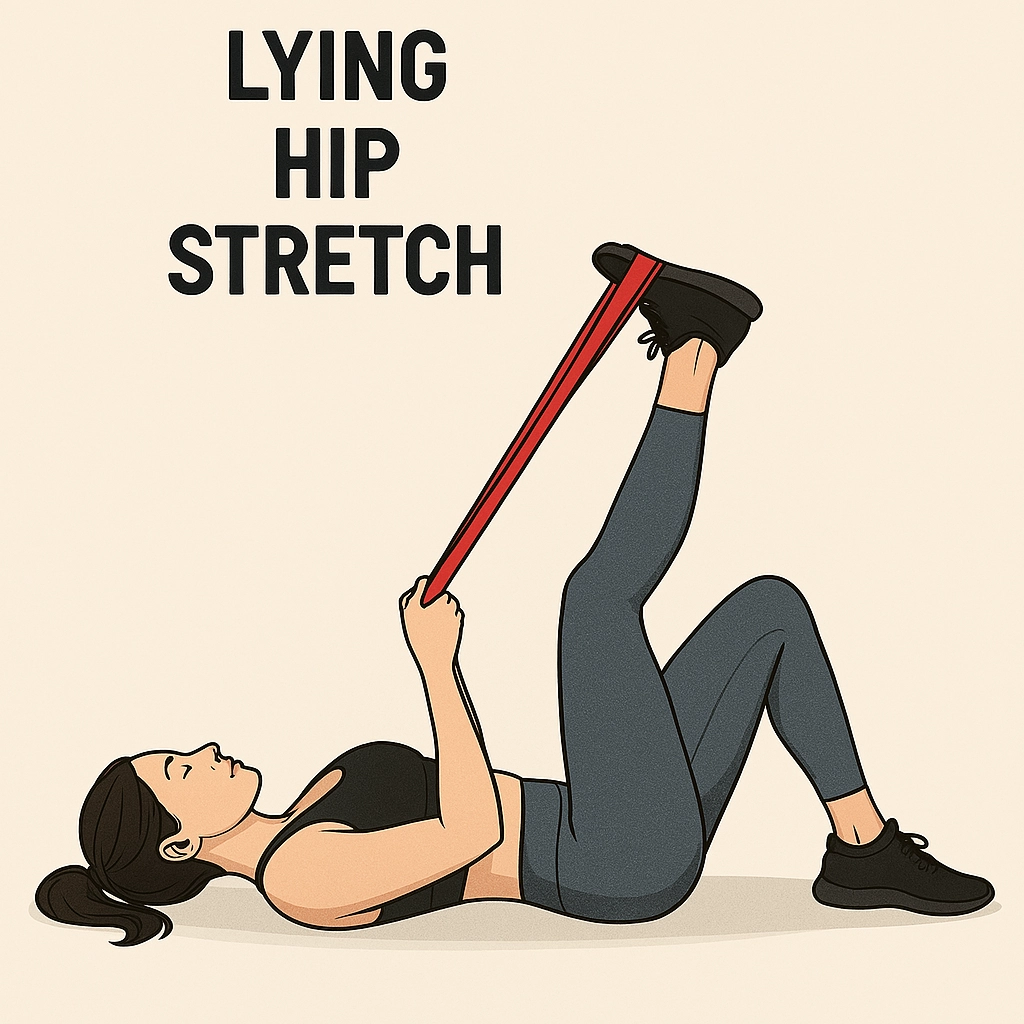
You’ll feel the stretch activate through your right hip and glute. Hold this position for 15-30 seconds before switching sides.
Remember, as Arnold would say, “The last three or four reps are what makes the muscle grow” – but with stretching, it’s about patient, controlled movement.
If you’re experiencing lower back pain, this stretch might be your secret weapon.
#Upper Back Stretch
Powerful upper back mobility begins with mastering this resistance band stretch, which targets the hard-to-reach muscles between your shoulder blades.
Here’s how to perform this effective stretch:
- Sit on the floor with legs extended straight
- Loop your resistance band around both feet
- Cross the band and grab each side with your hands near your feet
- Curl forward while maintaining engaged abs
- Hold the position for 15-30 seconds
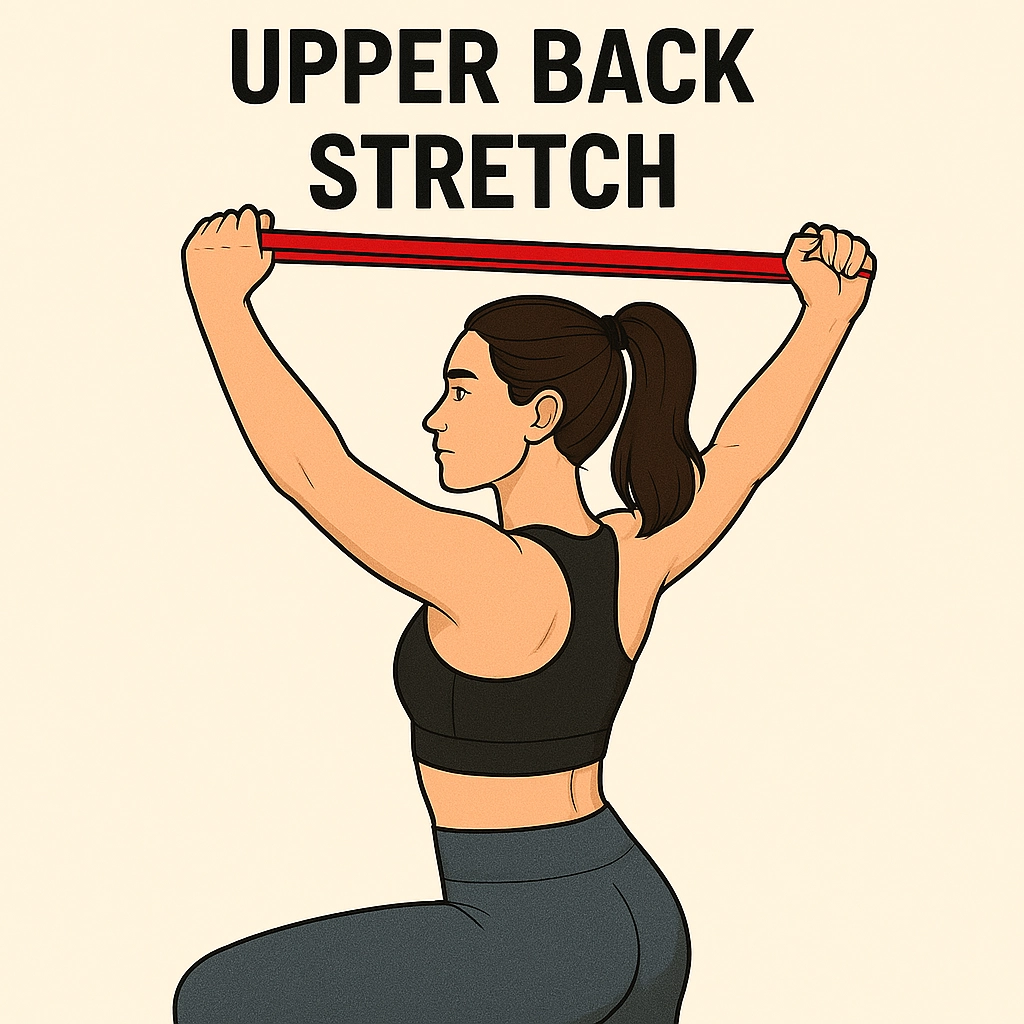
Remember to keep your core tight and avoid collapsing over your legs.
As you stretch, focus on spreading your shoulder blades while directing your chest toward your feet. If you experience any pain, release the stretch immediately and try alternative back stretches.
This movement, reminiscent of Arnold’s dedication to proper form, helps enhance your upper back flexibility and improves overall posture.
#Chest Stretch
To release maximum chest flexibility, this resistance band stretch targets tight pectoral muscles that often become restricted from daily activities.
Even Arnold knew the importance of maintaining chest flexibility to complement his legendary chest development.
Here’s how to perform the stretch:
- Sit cross-legged on the floor or in a chair with proper posture.
- Hold the resistance band with both hands, keeping them a few inches apart from each other.
- Pull your arms outward and downward as far as is comfortable.
- Maintain gentle tension – avoid aggressive pulling.
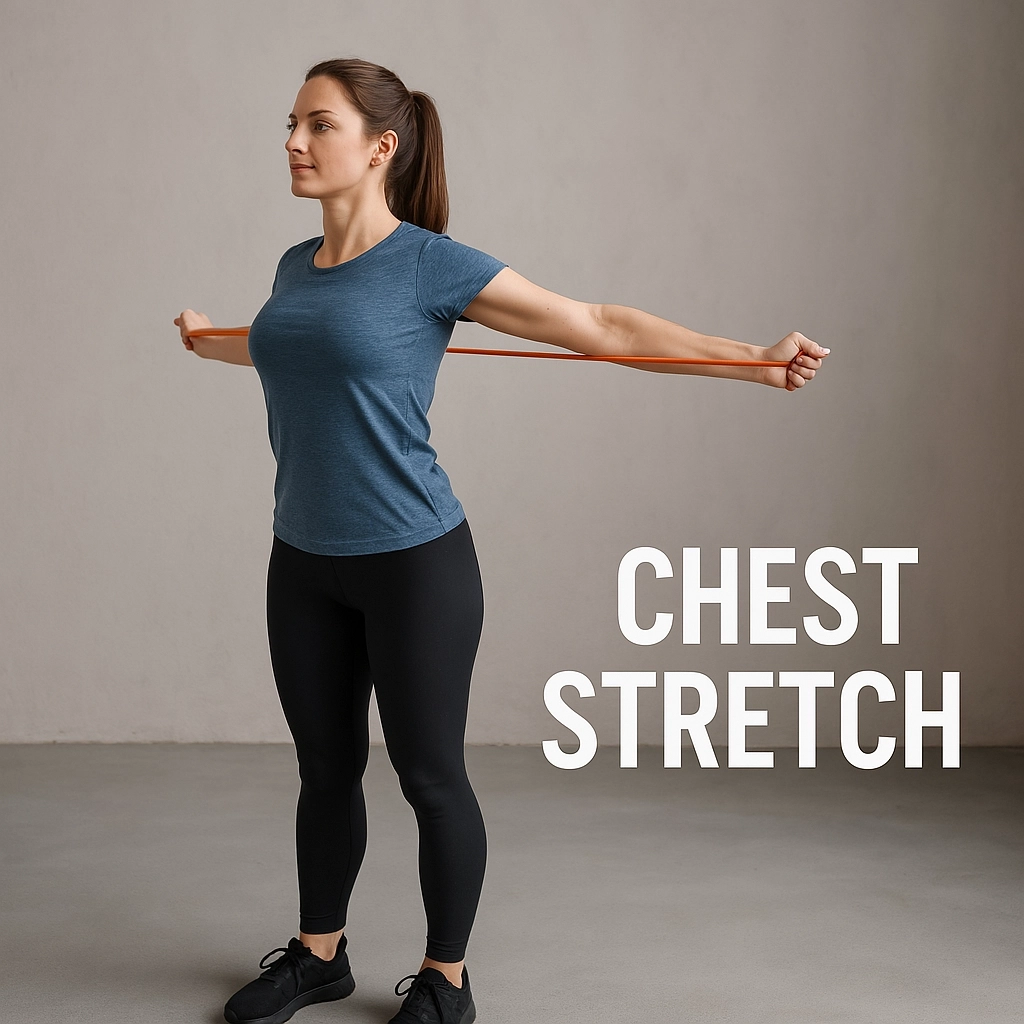
Key points:
- Adjust hand positioning to modify band tension.
- Focus on feeling the stretch across your chest.
- Listen to your body – if you have shoulder issues, skip this exercise.
- Keep breathing steadily throughout the movement.
The chest stretch is most effective when performed with controlled, mindful movements rather than forceful stretching.
#Side Stretch
Since tight obliques can limit your overall mobility, the side stretch using resistance bands offers an effective way to increase lateral flexibility and core range of motion.
Here’s how to perform the stretch:
- Sit either on a chair or cross-legged on the floor
- Hold one end of the band with your left hand
- Extend your arm toward the right side
- Grasp the other end with your right hand
- Create gentle tension by pulling the band
- Maintain an elongated stretch through your left waist
- Hold for 15-30 seconds
- Switch sides and repeat
Remember to keep your torso straight and core engaged throughout the movement.
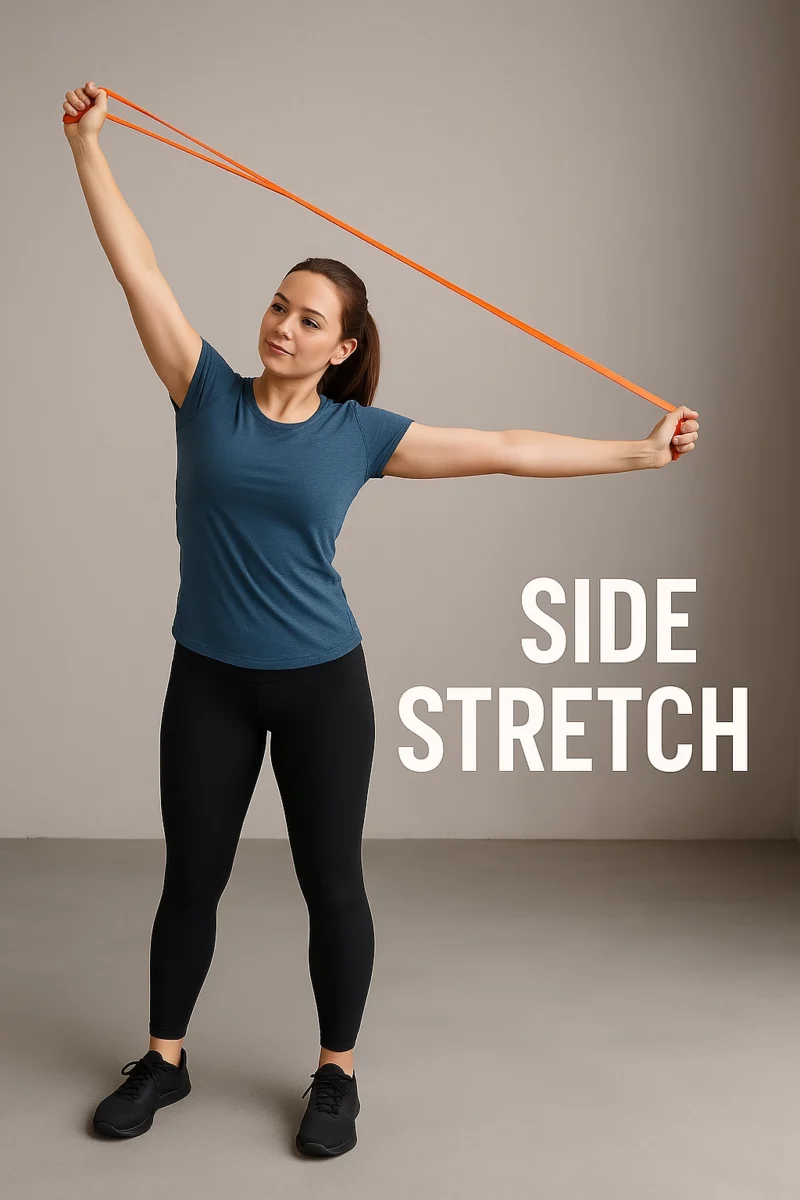
Don’t round your back – this common mistake reduces the effectiveness of the stretch. If you’re feeling pain while deepening the stretch, that’s your body’s signal to ease off.
You’ll develop greater flexibility over time, just as Arnold always said: “The last three or four reps are what makes the muscle grow.”
#Kneeling Quad Stretch
The kneeling quad stretch with resistance bands takes your regular quadriceps stretch to the next level by adding controlled tension.
Start by sitting on the floor with your right leg bent in front of you and your left leg behind you. If your knees are sensitive, place a folded towel underneath for cushioning.
Loop your resistance band around your left foot’s top portion, then lean onto your right forearm. Gently pull the band to guide your heel toward your glutes, creating a deep stretch along the front side of your thigh.
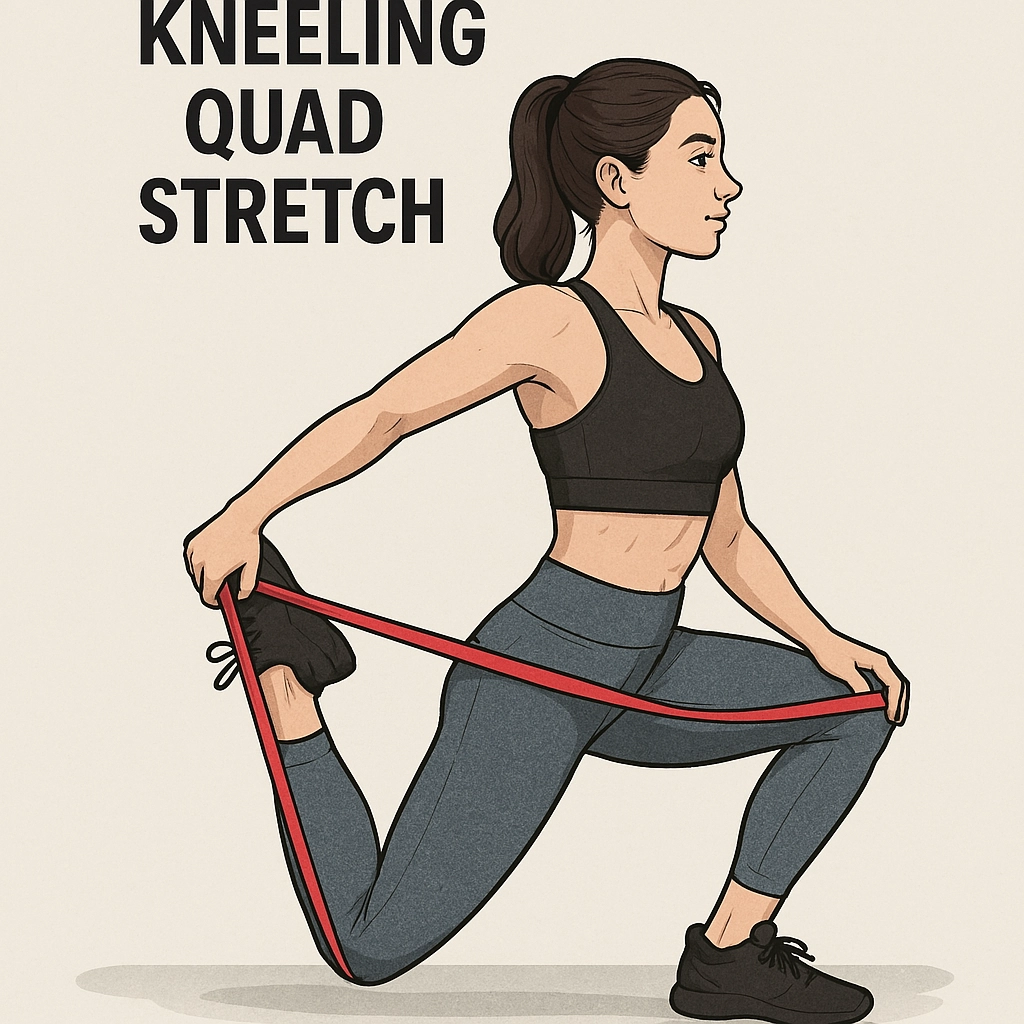
Hold this position for 15-30 seconds, focusing on steady breathing. When you’re ready to intensify the stretch, engage your glutes for a deeper, more effective muscle lengthening.
Remember to switch sides and repeat the same sequence with your opposite leg.
Safety and Precautions
While resistance bands offer an excellent way to enhance your stretching routine, it is essential to take proper safety measures to prevent injury and maximize results. There are two critical rules you’ll need to follow:
- Don’t perform ballistic stretching (bouncing movements) with resistance bands. This creates dangerous momentum that can force your body beyond its natural range of motion.
- Never push a stretch beyond your comfort zone. You’ll want to feel a gentle tension, not pain or strain.
Remember Arnold’s famous advice about progressive training – it applies to flexibility too. Just as you wouldn’t try to lift your maximum weight on day one, you shouldn’t attempt to achieve full splits immediately.
Instead, work gradually and consistently, allowing your flexibility to improve naturally over time. Listen to your body’s signals and adjust the intensity accordingly.
Advanced Band Stretching Techniques
Progressive overload helps muscles grow stronger. Use heavier bands over time. Start with a light band. Increase the resistance gradually. This allows the body to adapt and build strength. Track your progress weekly. Make sure to challenge yourself.
Combine band stretches with bodyweight exercises. This makes workouts more effective. Do squats with a resistance band. Try lunges while holding the band. Add push-ups with band resistance. This targets more muscle groups. Improve flexibility and strength together.
Common Mistakes To Avoid
Using a band that is too tight can cause strain. Always choose the proper tension level. Bands should not be too loose either. A band that is too loose won’t provide enough resistance. It is essential to check the band for any tears or wear. Using a damaged band can lead to injury.
Maintaining proper form is crucial. Avoid hunching your back while stretching. Keep your core engaged. This helps in preventing injuries. Stretching too fast can also be harmful. Slow and controlled movements are best. Always breathe properly during stretches. Never hold your breath.
To Wrap It All Up
While you might think resistance bands are just glorified rubber bands, they’re powerful tools for releasing flexibility you never knew you had. You’ll find that consistent practice with these stretches not only transforms your range of motion but also your entire fitness journey.
Ironically, it’s these simple elastic bands that can help you break through the most rigid barriers in your training, setting you free to achieve your peak performance.
FAQs
What Are Band Stretches and How Do They Work?
Band stretches use resistance bands to assist stretching by adding controlled tension to muscles and joints. They work by increasing range of motion, improving flexibility, and enhancing muscle activation through gentle resistance. Band stretches help maintain proper form and allow deeper, safer stretches than bodyweight alone.
Benefits of Using Resistance Bands for Stretching
Using resistance bands for stretching improves flexibility, increases range of motion, and enhances muscle activation. Bands provide controlled tension that deepens stretches safely. They help maintain proper alignment and allow targeted stretching of specific muscles, making them effective for warm-ups, recovery, and injury prevention routines.
Are Band Stretches Better Than Regular Stretches?
Band stretches are often better than regular stretches because they provide external resistance, improve flexibility, and deepen stretches safely. Resistance bands allow greater control and muscle activation compared to static stretches. However, combining both methods offers comprehensive flexibility and mobility benefits for all fitness levels.
Can Beginners Use Bands for Stretching?
Beginners can use bands for stretching safely to improve flexibility and range of motion. Resistance bands provide support and controlled tension, making stretches easier to perform with correct form. Light resistance bands are recommended for beginners to assist stretching without excessive force or strain on muscles.
How Do Band Stretches Improve Flexibility?
Band stretches improve flexibility by adding external resistance, which increases muscle elongation and joint range of motion. The bands create controlled tension that allows deeper and more effective stretches. They also enhance neuromuscular coordination, enabling muscles to relax and lengthen efficiently during stretching exercises.
Dynamic vs Static Band Stretches: What’s the Difference?
The main difference between dynamic and static band stretches is movement. Dynamic band stretches involve active, controlled movements to warm up muscles and increase blood flow. Static band stretches involve holding a stretch position with a band to improve flexibility and lengthen muscles after workouts.
Safety Tips for Stretching With Bands
When stretching with bands, ensure proper form, use appropriate resistance levels, and avoid overstretching to prevent injury. Always anchor bands securely to prevent slipping. Warm up before stretching and perform movements slowly and controlled. Check bands for damage before use to maintain safe stretching sessions.

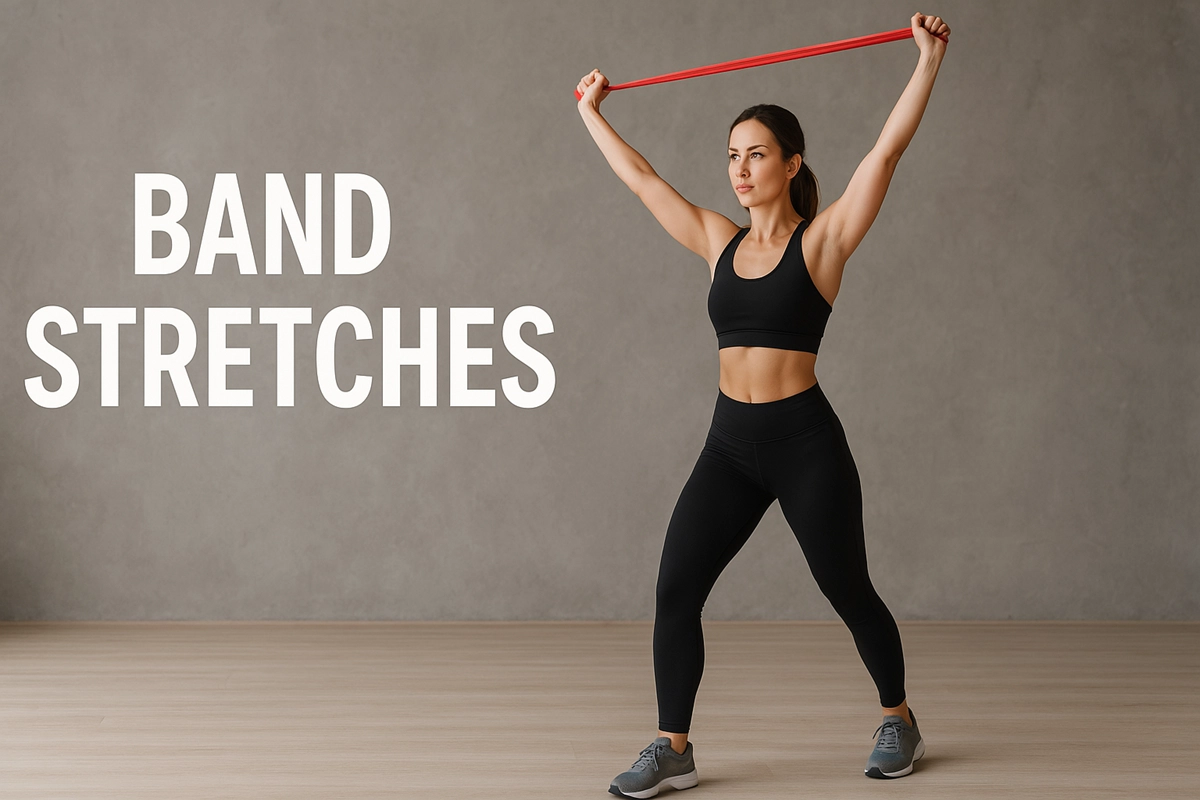

![The Ultimate Home Gym Guide For Women [13 Equipment Only] women home gym equipment guide](https://herculesbodybuilding.com/wp-content/uploads/2025/09/The-Ultimate-Home-Gym-Guide-For-Women-13-Equipment-Only-1200x800.webp)



